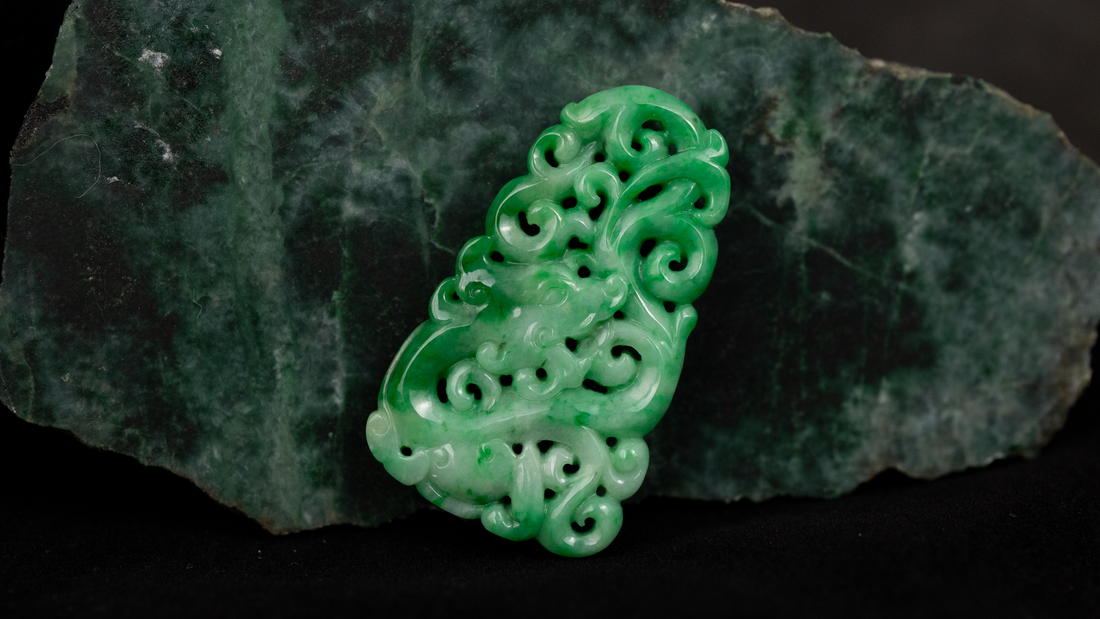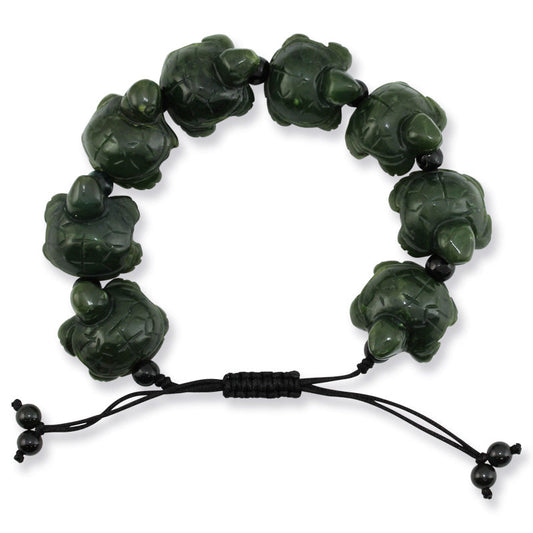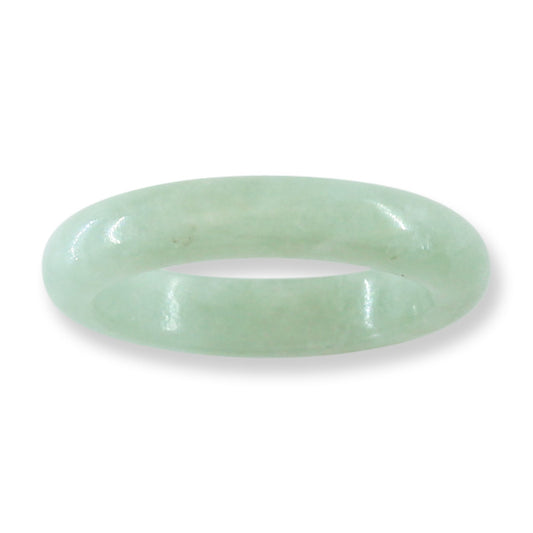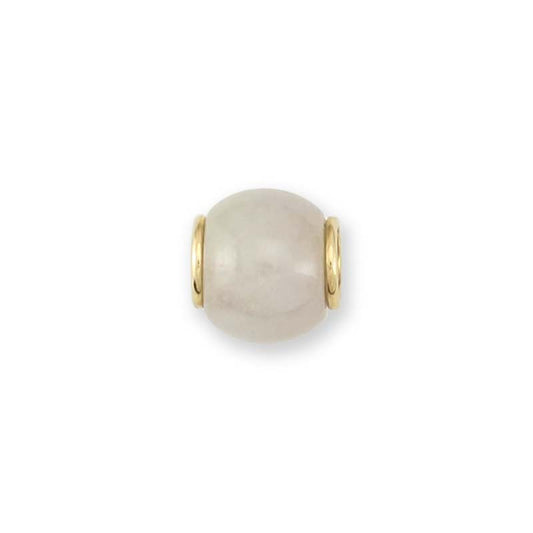In China, jade is deeply embedded in cultural tradition, and its symbolism has been revered for millennia. Jade is more than just a gemstone for jewelry, it's an art medium as well. When visiting jade markets in China, one often observes customers inquiring about the meaning behind specific carvings.
The jade dragon, in particular, is widely recognized among Chinese buyers for its powerful associations with protection, prosperity, and imperial authority. In recent years, growing appreciation for Chinese art and heritage in the United States has sparked a strong interest among American jewelry enthusiasts, who seek to understand not only the beauty of jade but also the rich symbolism and history it embodies.
Dragon carvings in nephrite jade go back to the neolithic Hongshan culture (5000 BC to 3000 BC,) long before the Shang Dynasty (1600 BC to 1050 BC,) and every Chinese dynasty that followed depicted the dragon in its own way. The Liang Zhu culture also saw significant appreciation for jade carving, which lasted from around 4500 BC to 2300 BC.
You can learn more about the neolithic use of jade in this video on Jewels of the Trade.

The Dragon: Power, Protection, and Wisdom
In Chinese mythology, the dragon is one of the most revered symbols. Unlike Western dragons, which are often depicted as fire-breathing destroyers, Chinese dragons are benevolent, associated with water rather than fire. They are seen as protectors—guardians of rivers, rain, and the people who depend on them.

Imperial Symbol
Throughout China’s dynastic history, the dragon represented imperial power. Emperors were often called “sons of the dragon,” and their robes were adorned with dragon motifs. This strong association with rulership made dragon carvings especially auspicious.
The Dragon and the Pearl of Wisdom
You’ll often see dragons in jade art reaching for, holding, or guarding a pearl. This pearl represents enlightened knowledge, spiritual energy, and power. In legend, dragons are said to roam the seas searching for pearls to feed on.
The Legend of the Boy and the Dragon Pearl
One famous story tells of a boy from a drought-stricken province who discovers a magical pearl that makes his rice multiply endlessly. When the greedy emperor tries to take it, the boy swallows the pearl to protect it. He transforms into a dragon, forever guarding the land and ensuring its prosperity. This tale reinforces the dragon’s role as a protector and bringer of abundance.
Special Dragon Carvings
The Dragon King (Longwang)
A powerful water and weather god, the Dragon King rules over seas and rivers. Carvings of him symbolize control over natural forces and are believed to offer protection against floods and storms.
The Nine Sons of the Dragon
These mythological offspring each have unique appearances and powers. They frequently appear in decorative art, each serving a protective or auspicious role.
The Hydra (Young Dragons)
Representing playfulness and lighthearted energy, depictions of young dragons (sometimes shown with multiple heads) bring a softer, joyful meaning to jade carvings.
The Phoenix (Fenghuang): Harmony and Renewal
The phoenix, known in Chinese as Fenghuang, is another powerful figure in jade art. Often paired with the dragon, the phoenix symbolizes the yin (feminine) to the dragon’s yang (masculine). Together, they represent balance, fertility, and marital harmony.
A Symbol of Peace and Virtue
Images of the phoenix have been found in Chinese art as far back as 7000 years ago, during the Hongshan Culture period, showing its deep cultural significance. The phoenix is said to appear only during times of peace and prosperity, making it a harbinger of harmony. It embodies high virtue, grace, and the sun’s energy. Historically, the image of the phoenix adorned the empress’s crown and garments, emphasizing its connection to feminine power and dignity.
Fu Dog: The Dog of Fo
Fu Dog carvings in jade are often confused with dragon carvings. Despite the name, Fu Dogs (also known as Lion Dogs or Shishi) are not dogs at all but stylized lions. They became symbols of protection and courage after Buddhism introduced lion imagery to China—at a time when lions were unknown there. Local artisans modeled their statues after native dogs, leading to their unique appearance.
Protective Purpose
Fu Dogs are traditionally placed at entrances to guard temples, tombs, palaces, and homes. They stand as fierce protectors against evil spirits.
Pi Xiu: Wealth and Protection
The Pi Xiu (also spelled Pixiu) is a mythical winged lion believed to be a powerful guardian in feng shui. Known for its insatiable appetite for gold, silver, and jewels, it is thought to draw wealth to its owner.
Symbolic Powers
- Guards homes and wards off evil spirits
- Brings good fortune
- Attracts and gathers wealth
- Drives away misfortune
- Because of these associations, Pi Xiu carvings are especially popular among those seeking prosperity and protection.
A pixiu carving can be distinguished from a fu dog carving by the presence of wings on the animal’s back.
If you would like to learn more, check out these videos of jade dragon carvings on Jewels of the Trade:
The Chinese Zodiac and Dragon Years
The Chinese zodiac (生肖 shēngxiào) is a repeating 12‑year cycle, with each year associated with an animal sign. The Dragon is the fifth in the cycle and occurs every 12 years. Each Dragon year is also paired with one of the five elements—Wood, Fire, Earth, Metal, or Water—which adds nuance to astrological interpretations.
In the 20th and 21st centuries, the Dragon years and their elements are:
| Dragon Year | Element | Zodiac Cycle Period |
|---|---|---|
| 1928–29 | Earth | Jan 23, 1928 – Feb 9, 1929 |
| 1940–41 | Metal | Feb 8, 1940 – Jan 26, 1941 |
| 1952–53 | Water | Jan 27, 1952 – Feb 13, 1953 |
| 1964–65 | Wood | Feb 13, 1964 – Feb 1, 1965 |
| 1976–77 | Fire | Jan 31, 1976 – Feb 17, 1977 |
| 1988–89 | Earth | Feb 17, 1988 – Feb 5, 1989 |
| 2000–01 | Metal | Feb 5, 2000 – Jan 23, 2001 |
| 2012–13 | Water | Jan 23, 2012 – Feb 9, 2013 |
| 2024–25 | Wood | Feb 10, 2024 – Jan 28, 2025 |
Many notable figures in history have been born in the Year of the Dragon, such as Martin Luther King Jr. (Earth Dragon, born 1929), Napoleon Bonaparte (Earth Dragon, born 1769), and Salvador Dalí (Metal Dragon, born 1904).
But the most overlooked figure born in the Year of the Dragon may have been Empress Xiaoxianchun (Earth Dragon, born 1712), the first wife of Emperor Qianlong of the Qing Dynasty. Qianlong is perhaps the most iconic emperor to jade collectors, as he massively expanded the imperial jade collection, patronized the renowned imperial kilns at Jingdezhen, and instituted jade tribute routes that made jade a symbol of cultural and political power at court. She became his first empress consort and was widely respected for her virtues, cultural refinement, and moral leadership. Her life and influence are featured prominently in the C-Drama (Chinese historical drama) Ruyi’s Royal Love in the Palace, which dramatizes her marriage to Qianlong and the imperial politics of their day.
While the writer of this article is deeply interested in historical empresses and consorts of China’s dynastic past, locating details about them can be exceptionally challenging. Many early imperial biographies omit zodiac signs altogether. Documentation only becomes more reliable in the late Ming and Qing periods, where scholars can trace precise birthdates. Outside of Empress Xiaoxianchun, there are few empresses or consorts whose Dragon‑year status can be definitively established.
Here are some other notable imperial women and their respective zodiac signs:
| Name | Birth Year | Chinese Zodiac Sign | Dynasty | Notes |
|---|---|---|---|---|
| Empress Wu Zetian | 624 | Horse | Tang Dynasty | The only woman to rule as emperor in Chinese history - without a husband or son in power. Born 624 AD, Year of the Wood Horse. |
| Empress Dowager Cixi | 1835 | Goat | Qing Dynasty | Powerful regent who controlled Qing court for decades. Born Year of the Wood Goat. **Check out Jung Chang's biography on Cixi! Highly recommend!!! |
| Empress Xiaoxianchun | 1712 | Dragon | Qing Dynasty | First wife of Emperor Qianlong; Earth Dragon year. |
| Empress Dowager Longyu | 1868 | Monkey | Qing Dynasty | Last empress consort of the Qing dynasty. Born Year of the Earth Monkey. |
| Empress Lü Zhi | c. 241 BC | Unknown (no records) | Han Dynasty | Wife of Emperor Gaozu of Han; first empress of Han dynasty. Zodiac not recorded. |










